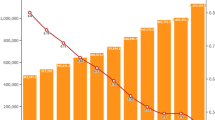Abstract
Environmental problems are threatening China’s sustainable future. China began the implementation of several environmental policies in the late 1970s and the stringency of these regulations is increasing. We utilize province-level data over the period 1987–2001 to measure various components of productivity within a joint production model that considers both market and environmental outputs. We estimate both Malmquist and Luenberger productivity indices and find that environmental management in China is deteriorating, while the productivity level of joint production is relatively constant.
Similar content being viewed by others
References
Balk BM (1998) Industrial price, quantity, and productivity indices: the micro-economic theory and an application. Kluwer, Boston
Boussemart JP, Briec W, Kerstens K, Poutineau JC (2003) Luenberger and Malmquist productivity indices: theoretical comparisons and empirical illustration. Bulletin of Economic Research 55:391–405
Caves DW, Christensen LR, Diewert WE (1982) The economic theory of index numbers and the measurement of input, output and productivity. Econometrica 50:1393–1414
Chambers RG (2002) Exact nonradial input, output, and productivity measurement. Economic Theory 20:751–765
Chambers RG, Färe R, Grosskopf S (1996) Productivity growth in APEC countries. Pacific Economic Review 1:181–190
Chambers RG, Chung Y, Färe R (1998) Profit, directional distance functions, and Nerlovian efficiency. Journal of Optimization Theory and Applications 98:351–364
Dasgupta S, Huq M, Wheeler D (1997) Bending the rules: discretionary pollution control in China. Policy Research Working Paper 1761, Development Research Group, World Bank, Washington DC
Debreu G (1951) The coefficient of resource utilization. Econometrica 19:273–292
Economy EC (2004) The river runs black: the environmental challenge to China’s future. Cornell University Press, Ithaca
Energy Research Institute (2003) Energy Statistics of Non-OECD Countries, The International Energy Agency (IEA), Paris
Färe R, Grosskopf S, Lovell CAK (1985) The measurement of efficiency of production. Kluwer-Nijhoff, Boston
Färe R, Grosskopf S, Norris M, Zhang Z (1994) Productivity growth, technical progress, and efficiency change in industrialized countries. American Economic Review 84:66–83
Farrell MJ (1957) The measurement of productive efficiency. Journal of the Royal Statistical Society 120:253–281
Jaffe AB, Newell RG, Stavins RN (2003) Technological change and the environment. In: Mäler K-G, Vincent J (eds) Handbook of environmental economics. North-Holland, Amsterdam, pp 462–516
Kai S (1996) Maintenance and response of wastewater plants. Environmental Protection 222:8–9
Luenberger DG (1992a) Benefit functions and duality. Journal of Mathematical Economics 21:461–481
Luenberger DG (1992b) New optimality principles for economic efficiency and equilibrium. Journal of Optimization Theory and Applications 75:221–264
Luenberger DG (1995) Microeconomic theory. McGraw-Hill, New York
Ma X, Ortolano L (2000) Environmental regulation in China. Lanham, Rowman and Littlefield, Washington DC
Malmquist S (1953) Index numbers and indifference curves. Trabajos de Estatistica 4:209–242
Managi S (2003) Luenberger and Malmquist productivity indices in Japan, 1955–1995. Applied Economics Letters 10:581–584
Managi S (2004) Competitiveness and environmental policies for agriculture: testing the Porter hypothesis. International Journal of Agricultural Resources, Governance and Ecology 3:310–324
Managi S, Opaluch JJ, Jin D, Grigalunas TA (2004) Technological change and depletion in offshore oil and gas. Journal of Environmental Economics and Management 47:388–409
Managi S, Opaluch JJ, Jin D, Grigalunas TA (2005) Environmental regulations and technological change in the offshore oil and gas industry. Land Economics 81:303–319
McCain RA (1978) Endogenous bias in technical progress and environmental policy. American Economic Review 68:538–546
Ray SC, Desli E (1997) Productivity growth, technical progress, and efficiency change in industrialized countries: comment. American Economic Review 87:1033–1039
Shephard RW (1970) Theory of cost and production functions. Princeton University Press, Princeton, NJ
Sinkule BJ, Ortolano L (1995) Implementing environmental policy in China. Praeger, Westport, CT
Wang H, Wheeler D (1996) Pricing industrial pollution in China: an econometric analysis of the levy system. Policy Research Working Paper No. 1644, Development Research Group, World Bank, Washington DC
Wang H, Wheeler D (2000) Endogenous enforcement and effectiveness of China’s pollution levy system. Policy Research Working Paper No. 2336, Development Research Group, World Bank, Washington DC
Wang H, Mamingi N, Laplante B, Dasgupta S (2002) Incomplete enforcement of pollution regulation: bargaining power of Chinese factories. Policy Research Working Paper No. 2756, Development Research Group, World Bank, Washington DC
Wang Y, Yao Y (2003) Sources of China’s economic growth 1952–1999: incorporating human capital accumulation. China Economic Review 14:32–52
World Bank (1997) Clear water, blue skies: China: environment in the new century. World Bank, Washington DC
World Bank (2001) China air, land and water: environmental priorities for a new millennium. World Bank, Washington DC
Xu X (2004) China’s gross domestic product estimation. China Economic Review 15:302–322
Author information
Authors and Affiliations
About this article
Cite this article
Managi, S., Kaneko, S. Productivity of market and environmental abatement in China. Environ Econ Policy Stud 7, 459–470 (2006). https://doi.org/10.1007/BF03353951
Received:
Accepted:
Published:
Issue Date:
DOI: https://doi.org/10.1007/BF03353951




